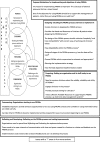The facilitators and barriers to implementing patient reported outcome measures in organisations delivering health related services: a systematic review of reviews
- PMID: 30363333
- PMCID: PMC6170512
- DOI: 10.1186/s41687-018-0072-3
The facilitators and barriers to implementing patient reported outcome measures in organisations delivering health related services: a systematic review of reviews
Abstract
Background: There is increasing interest in using Patient Reported Outcome Measures (PROMs) within organisations delivering health related services. However, organisations have had mixed success in implementing PROMs and there is little understanding about why this may be. Thus, the purpose of this study was to identify the facilitators and barriers to implementing PROMs in organisations.
Method: A systematic review of reviews was undertaken. Searches were conducted of five electronic databases: MEDLINE, EMBASE, CINAHL, PsycINFO and the Cochrane Database of Systematic Reviews, during the week of the 20th February 2017. Additional search methods included website searching and reference checking. To be included, a publication had to be a review of the literature, describe its methods and include information related to implementing PROMs. The reviews were extracted using a standardised form and assessed for their risk of bias using the Risk of Bias in Systematic Reviews tool. The findings were synthesised using the Consolidated Framework for Implementation Research. The protocol was registered on the International Prospective Register of Systematic Reviews database (PROSPERO) (CRD42017057491).
Results: Initially 2047 records were identified. After assessing eligibility, six reviews were included. These reviews varied in their review type and focus. Different issues arose at distinct stages of the implementation process. Organisations needed to invest time and resources in two key stages early in the implementation process: 'designing' the processes for using PROMs within an organisation; and 'preparing' an organisation and its staff. The 'designing' stage involved organisations planning not just which PROMs to use and how to administer them, but also how the data would be used for clinical purposes. The 'preparing' stage involved getting an organisation and its staff ready to use PROMs, particularly persuading clinicians of the validity and value of PROMs, delivering training, and developing electronic systems. Having an implementation lead overseeing the process and developing the process based on feedback were also identified as facilitating implementation.
Conclusion: Organisations implementing PROMs need to invest time and resources in 'designing' the PROMs strategy and 'preparing' the organisation to use PROMs. Focusing on these earlier stages may prevent problems arising when PROMs are used in practice.
Keywords: Implementing; Outcome assessment; Patient-reported outcomes; Quality of life.
Conflict of interest statement
Not applicable.Not applicable.The authors declare that they have no competing interests.Springer Nature remains neutral with regard to jurisdictional claims in published maps and institutional affiliations.
Figures
References
-
- Devlin N, Appleby J. (2010). Getting the most out of PROMs- putting health outcomes at the heart of NHS decision-making. Available from: https://www.kingsfund.org.uk/sites/default/files/Getting-the-most-out-of.... Accessed 12th Jan 2017.
-
- Greenhalgh J., Pawson R., Wright J., Black N., Valderas J. M., Meads D., Gibbons E., Wood L., Wood C., Mills C., Dalkin S. Functionality and feedback: a protocol for a realist synthesis of the collation, interpretation and utilisation of PROMs data to improve patient care. BMJ Open. 2014;4(7):e005601–e005601. doi: 10.1136/bmjopen-2014-005601. - DOI - PMC - PubMed
-
- Bausewein Claudia, Simon Steffen T, Benalia Hamid, Downing Julia, Mwangi-Powell Faith N, Daveson Barbara A, Harding Richard, Higginson Irene J. Implementing patient reported outcome measures (PROMs) in palliative care - users' cry for help. Health and Quality of Life Outcomes. 2011;9(1):27. doi: 10.1186/1477-7525-9-27. - DOI - PMC - PubMed
Publication types
Grants and funding
LinkOut - more resources
Full Text Sources



